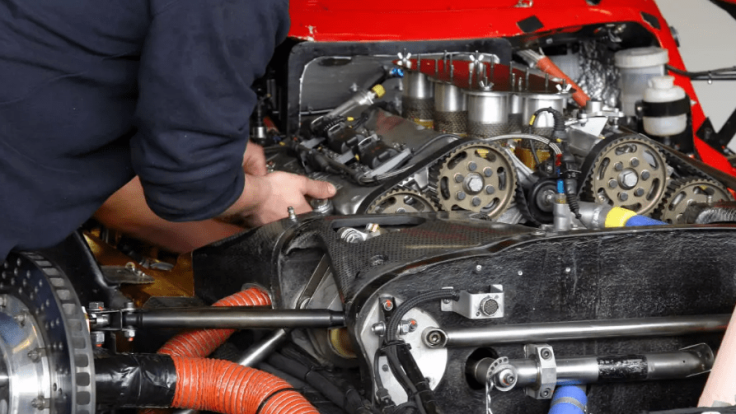Pros & Cons of Range Rover Engine Replacement
- Posted on September 30, 2024
- blogs
- By Administrator
- 2097 Views

Moving from one competition’s offering to another is not simple. Replacing the engine of a high-performance luxury SUV such as a Range Rover is quite a complicated task. There is a need to look at the more technical aspects in terms of Range Rover engine replacement.
In this article, the pros and cons of the process of car engine replacement from an engineering point of view are discussed.
Technical Pros of Range Rover Engine Replacement
Restored Engine Efficiency
As time passes, the engine’s performance changes due to the wear or tear of internal components. These components include pistons, valves, camshafts, etc. These affect the fuel efficiency and power output. A new or rebuilt replacement engine typically operates at optimal efficiency levels. So it is necessary to restore engine efficiency to maintain your Range Rover performance.
Advanced Engineering Components
Advanced technologies are being used in new engines. Replacing old engines is good for your car. A new engine includes advanced components such as forged aluminium pistons, lighter crankshafts, and updated turbochargers. With the help of these components your replacement engine's durability or performance of the car increases.
|
Component Name |
Function |
Key Materials Used |
Applications |
Advanced Features |
|
Composite Materials |
High strength-to-weight ratio, corrosion resistance |
Carbon Fiber, Kevlar, Glass Fiber |
Aerospace, Automotive, Wind Turbines, Sporting Goods |
Lightweight, high durability, and flexibility |
|
High-Performance Alloys |
Withstand extreme temperatures and pressures |
Nickel, Titanium, Aluminum |
Aerospace, Power Generation, Oil & Gas |
Heat and corrosion resistance, mechanical strength at high temperatures |
|
Nanomaterials |
Enhances properties like strength, conductivity, and flexibility |
Carbon Nanotubes, Graphene, Nanowires |
Electronics, Biomedical, Coatings, Solar Cells |
Atomic-scale control, increased conductivity, and mechanical strength |
|
Smart Materials |
Respond to environmental stimuli such as temperature, pressure, or electrical field |
Shape-Memory Alloys, Piezoelectric |
Robotics, Aerospace, Medical Devices, Wearable Tech |
Shape change under external stimuli, energy harvesting, and adaptive behavior |
|
Advanced Ceramics |
Extreme hardness, resistance to wear, and high-temperature performance |
Alumina, Zirconia, Silicon Carbide |
Aerospace, Biomedical Implants, Industrial Cutting Tools |
Excellent thermal stability, high hardness, and resistance to chemical corrosion |
|
3D-Printed Components |
Customizable and complex geometries with precise tolerances |
Thermoplastics, Metals, Ceramics |
Prototyping, Aerospace, Medical Implants, Automotive |
Cost-effective customization, rapid prototyping, and reduced waste |
|
Semiconductors |
Fundamental building blocks for electronic devices |
Silicon, Germanium, Gallium Arsenide |
Electronics, Computing, Telecommunications |
High electrical conductivity, miniaturization of devices, and efficient energy usage |
|
Sensors & Actuators |
Convert physical stimuli into electrical signals or mechanical movement |
MEMS, Piezoelectric Materials |
IoT, Automation, Robotics, Medical Devices |
High precision, small form factor, and integration with smart systems |
|
Advanced Polymers |
Tailored for strength, flexibility, and chemical resistance |
Polyethylene, Polypropylene, Nylon |
Medical Devices, Automotive, Aerospace, Packaging |
High impact resistance, flexibility, and chemical inertness |
|
Metal Matrix Composites |
Combine metal matrix with ceramic or fibre reinforcements for improved mechanical properties |
Aluminum, Titanium with SiC or Carbon |
Automotive, Aerospace, Defense, Sporting Goods |
Increased stiffness, strength, and wear resistance |
Enhanced Cooling Systems
Engine features improve the water pumps, better radiator designs, and updated coolant systems. This helps the replacement engines to work more efficiently. A good cooling system helps your Range Rover engine to prevent overheating, especially in off-road driving or towing.
Improved Electronics and Sensor Integration
New engines are now upgraded with advanced technology. Advanced sensors such as oxygen, crankshaft position, and knock sensors are now all present in new engines. These features offer accuracy to ECU. These sensors ensure that the auto engine replacement will have better fuel management, emissions control, and smoother operation. Moreover, these provide a seamless driving experience.
|
Ent/System |
Function |
Key Technologies/Materials |
Applications |
Advanced Features |
|
MEMS Sensors |
Micro-electromechanical systems for precise detection of physical changes |
Silicon, Polymers, Piezoelectric materials |
Automotive, Medical Devices, Wearables, Industrial Automation |
Miniaturization, high precision, low power consumption, and integration with electronics |
|
IoT Sensor Networks |
Connect multiple sensors for real-time data acquisition and communication |
Wireless Sensors, Cloud Computing |
Smart Cities, Industrial IoT, Agriculture, Home Automation |
Real-time data monitoring, wireless communication, and scalability for large networks |
|
Flexible Electronics |
Bendable and stretchable electronic circuits for integration into unconventional surfaces |
Organic Semiconductors, Conductive Polymers |
Wearable Tech, Flexible Displays, Medical Devices, Robotics |
Lightweight, flexible form factor, durable, and conform to various surfaces |
|
Photonic Sensors |
Use of light to detect changes in temperature, pressure, and chemical properties |
Fiber Optics, Photonic Crystals |
Telecommunications, Medical Imaging, Environmental Monitoring |
High sensitivity, fast response time, immune to electromagnetic interference |
|
LIDAR Systems |
Light detection and ranging for distance and object detection |
Laser Emitters, Sensors, Reflectors |
Autonomous Vehicles, Drones, Robotics, Surveying |
High-resolution 3D mapping, long-range detection, and precision object tracking |
|
Smart Sensors |
Combine sensing capabilities with data processing and communication |
Embedded Processors, Machine Learning |
Industrial Automation, Smart Homes, Wearable Devices |
Real-time analytics, wireless communication, and adaptive responses to stimuli |
|
Wearable Sensors |
Integrated sensors in clothing or accessories for monitoring physiological parameters |
Conductive Fabrics, Flexible Sensors |
Healthcare, Fitness, Military, Personal Monitoring |
Lightweight, continuous monitoring, user-friendly interfaces, and data integration with mobile devices |
|
Environmental Sensors |
Measure environmental conditions like air quality, temperature, and humidity |
Gas Sensors, Temperature Sensors, Hygrometers |
Smart Cities, Agriculture, HVAC Systems |
Low power consumption, high sensitivity to environmental changes, and remote monitoring capabilities |
|
Embedded Systems |
Dedicated computer systems within a larger mechanical or electrical system to control specific functions |
Microcontrollers, FPGAs, ASICs |
Automotive, Aerospace, Consumer Electronics, Robotics |
Real-time processing, low power consumption, and high reliability for control functions |
|
RFID & NFC |
Wireless communication technologies for tracking and data exchange |
Radio Frequency Circuits, Antennas |
Asset Tracking, Contactless Payments, Access Control |
Long-range detection (RFID), secure and short-range communication (NFC), easy integration with systems |
|
Advanced Signal Processing |
Processes and analyzes sensor data for improved accuracy and efficiency |
Digital Signal Processors (DSP), AI |
Telecommunications, Imaging Systems, Robotics, Medical Devices |
Noise reduction, real-time processing, and enhanced accuracy for complex data analysis |
|
Optoelectronics |
Converts electrical signals to light and vice versa for sensing and communication |
LEDs, Photodetectors, Semiconductor Lasers |
Telecommunications, Imaging Systems, Medical Devices |
High efficiency, fast response times, and integration with fibre-optic communication systems |
Reduction In Noise, Vibration, and Harshness (NVH)
In your vehicle’s old engine, you may face different NVH problems. Car engine replacement is helpful for Range Rover to improve NVH levels. The advanced technology is being used in modern engines to make them vibration-dampening. These can tolerate the outside environment more powerfully. As a result, you can enjoy a smooth driving experience on the roads.
Technical Cons of Range Rover Engine Replacement
Complex ECU Reprogramming
New engine replacement may face some ECU issues. ECU controls the fuel injection, timing, and emissions in an engine. If your ECU does not match with the new engine this could lead to erratic engine behavior, requiring ECU reprogramming or even replacement. This adds to the overall engine replacement cost.
Transmission and Drivetrain Compatibility Issues
Once you replace your car engine without verifying compatibility with the existing transmission, this can be harmful for the vehicle. Your engine can face improper gear shifts, delayed acceleration, or excessive wear on drivetrain components. Proper drivetrain modifications are required for the upgrading of the replacement engine. These modifications include strengthening axles or upgrading the transfer case which increases both complexity and cost.
Advanced Cooling and Oil System Considerations
While improved cooling systems are a technical benefit. Integrating them into an older vehicle may require additional modifications.
For example, new engines with higher performance outputs often require more efficient radiators, oil coolers, or additional cooling fans. Failing to upgrade these systems can lead to overheating, and diminished engine life during extreme driving conditions.
Potential Sensor and Wiring Incompatibility
You may face different electrical system problems when you replace an engine. Remember, the wiring harness, sensors or connectors are different for each engine. So replacement engines may face these incompatibility issues. Inaccurate readings, faulty system warnings, or even engine misfires are some of the incompatibilities you may face in engine replacement in your Range Rover engine.
Conclusion
Engine replacement in Range Rover is a technical decision. Although it has several advantages of replacing engines but requires keen research. This research is necessary to select the best one which suits your vehicle. The drawbacks centre around high engine replacement costs, compatibility issues, and the need for technical expertise.
Every process of replacing a car engine should involve a professional technician and adequate understanding of the entire process. Replacing the engine of your Range Rover makes you regain the best performance of the car.

